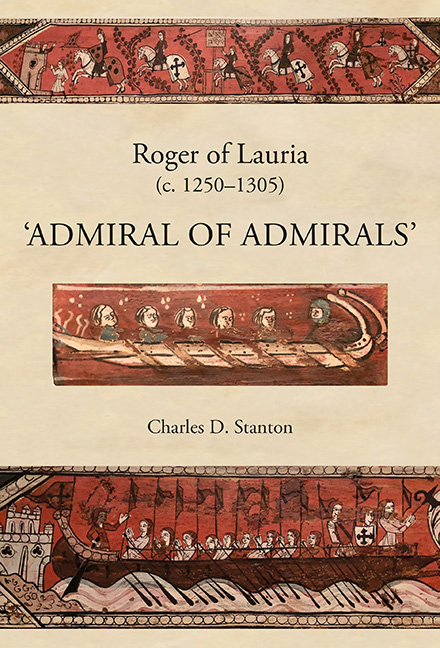Book contents
- Frontmatter
- Dedication
- Contents
- List of Illustrations
- Prologue
- 1 Battle of Benevento (26 February 1266)
- 2 A Calabrian Exile in the Court of Aragon (1262–1282)
- 3 Battle of Tagliacozzo (23 August 1268)
- 4 Aragonese Expansion (1229–1282)
- 5 Angevin Consolidation and Aggrandizement (1268–1282)
- 6 Revolt of the Vespers (30 March 1282)
- 7 Aragonese Intervention (August–October 1282)
- 8 Stalemate (November 1282–March 1283)
- 9 Admiral of Aragon (20 April 1283)
- 10 The Opposing Fleets (1282–1302)
- 11 Battle of Malta (8 June 1283)
- 12 Anjou's Dreams of Empire Dashed (June–November 1284)
- 13 France's Crusade Against Aragon (May–November 1285)
- 14 Battle of the Counts (23 June 1287)
- 15 Truces and Treaties (June 1287–November 1291)
- 16 Raid on Romania (Summer 1292)
- 17 Switching Sides (December 1293–April 1297)
- 18 Aragon's Invasion of Sicily at Anjou's Bidding (1298/1299)
- 19 Lauria's Last Great Campaign (Summer 1299–Spring 1300)
- 20 Endgame (Spring 1301–Summer 1302)
- Epilogue
- Bibliography
- Index
8 - Stalemate (November 1282–March 1283)
Published online by Cambridge University Press: 24 October 2019
- Frontmatter
- Dedication
- Contents
- List of Illustrations
- Prologue
- 1 Battle of Benevento (26 February 1266)
- 2 A Calabrian Exile in the Court of Aragon (1262–1282)
- 3 Battle of Tagliacozzo (23 August 1268)
- 4 Aragonese Expansion (1229–1282)
- 5 Angevin Consolidation and Aggrandizement (1268–1282)
- 6 Revolt of the Vespers (30 March 1282)
- 7 Aragonese Intervention (August–October 1282)
- 8 Stalemate (November 1282–March 1283)
- 9 Admiral of Aragon (20 April 1283)
- 10 The Opposing Fleets (1282–1302)
- 11 Battle of Malta (8 June 1283)
- 12 Anjou's Dreams of Empire Dashed (June–November 1284)
- 13 France's Crusade Against Aragon (May–November 1285)
- 14 Battle of the Counts (23 June 1287)
- 15 Truces and Treaties (June 1287–November 1291)
- 16 Raid on Romania (Summer 1292)
- 17 Switching Sides (December 1293–April 1297)
- 18 Aragon's Invasion of Sicily at Anjou's Bidding (1298/1299)
- 19 Lauria's Last Great Campaign (Summer 1299–Spring 1300)
- 20 Endgame (Spring 1301–Summer 1302)
- Epilogue
- Bibliography
- Index
Summary
IT WAS NOT LONG BEFORE CHARLES of Anjou realized how precarious his position had become. Correctly fearing communication with the Angevin-dominated northern Regno could be compromised by Aragonese amphibious actions, he quickly sought to bolster his diminished forces in Reggio, beginning with the easiest element to reinforce – the ground component. Following the departure of feudal forces that had satisfied their military service obligations, Bartolomeo Neocastro calculated that only 7,000 knights and 10,000 foot soldiers remained of the great army Anjou had massed for the siege of Messina. Saba Malaspina suggested an additional 3,000 salaried crossbowmen plus perhaps a few hundred Saracens from Lucera also stayed. Giovanni Amatuccio speculates that, all told, no more than 5,000 horse and 15,000 infantry withstood the dissolution of the invasion force subsequent to its evacuation from Sicily – and those numbers were dwindling by the day.
So, in early November 1282, Anjou petitioned his brother's heir, King Philip III, for a loan of 5,000 ounces of gold in order to raise 200 mounted men and 3,000 infantry in Provence under Raymond Amiel of Marseilles. In the same timeframe, he summoned from the heart of Capetian France two contingents of mounted men: the first consisting of 600 ‘armed men’ under his son, Charles the Lame; and the second composed of 1,000 knights led by his nephews, Robert II of Artois and Peter I of Alençon. Additionally, Pope Martin IV, who had formally excommunicated Peter of Aragon in mid-November, dispatched to Anjou's aid 500 French knights, contracted for a period of six months with coin from the coffers of the papal Curia.
Augmentation of his eroded naval forces was more problematic and protracted. First of all, he ordered Gazo Chinard, son of Philippe Chinard (King Manfred's admiral of the fleet), to take command of the surviving ships of Apulia and the Abruzzi. He then recalled Narjot de Toucy (son of deceased Admiral Philippe de Toucy) from the Principality of Achaea, where he was serving as bailiff, so that he could reassume his old position as admiral of the Angevin fleet. Concurrently, Charles tasked regnicoli aristocrats, Riccardo Riso and Luigi de Monti, to oversee the repair of old galleys and the construction of new ones in the arsenals of the Principato of Salerno, the Terra di Lavoro (‘Land of Work’ – southern Lazio and northern Campania), the Abruzzi and Apulia.
- Type
- Chapter
- Information
- Roger of Lauria (c.1250–1305)‘Admiral of Admirals’, pp. 104 - 114Publisher: Boydell & BrewerPrint publication year: 2019



